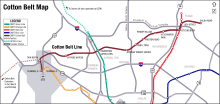Silver Line (Dallas Area Rapid Transit)
The Silver Line, also known as the Cotton Belt Rail Line, is an under construction 26-mile (42 km) commuter rail line traversing Collin, Dallas, and Tarrant Counties in the U.S. state of Texas operated by DART Dallas Area Rapid Transit. The line will provide service from Dallas's northeast suburbs of Plano, Richardson, and Addison to Dallas/Fort Worth International Airport Terminal B.
| Silver Line | |
|---|---|
 | |
| Overview | |
| Other name(s) | Cotton Belt Rail Line |
| Type | Commuter rail |
| System | Dallas Area Rapid Transit |
| Status | Under construction |
| Locale | Collin County, Dallas County, and Tarrant County Texas, USA |
| Termini | Shiloh Road Station DFW Airport/Terminal B station |
| Stations | 10 |
| Services | 1 |
| Daily ridership | 7,000 (estimated)[1] |
| Website | DART Cotton Belt Rail Line |
| Operation | |
| Planned opening | December 28, 2022 |
| Owner | DART |
| Operator(s) | DART |
| Character | commuter rail on shared freight line |
| Depot(s) | Trinity Railway Express Maintenance Facility |
| Rolling stock | 8 Stadler FLIRT sets |
| Technical | |
| Line length | 26 mi (41.84 km)[2] |
| Track length | 67.7 mi (108.95 km) |
| Number of tracks | 2[3] |
| Track gauge | 4 ft 8 1⁄2 in (1,435 mm) standard gauge |
| Operating speed | 79 mph (127 km/h) (top)[3] ~26 mph (42 km/h) (average) |
According to DART, the Silver Line is "designed to provide a high-speed, reliable transit option for residents and commuters with connections to the existing and planned transit systems" and aims to improve transit travel times by providing an alternative to congested roadway networks.[4]
The working name for the project, the Cotton Belt Rail Line, comes from a former subsidiary of the Southern Pacific Railroad, the St. Louis Southwestern Railway, commonly known as the Cotton Belt, which previously owned the line. DART purchased the right-of-way in 1990 for future transit use.
History
Cotton Belt service along the line has been in planning since the original 1983 DART Service Plan.[4][5] DART previously bought the right-of-way to the 52 miles (84 km) Cotton Belt corridor train tracks in 1990 and freight trains had since ceased use of the tracks.[6][7] The line was also included in DART's 2030 Transit System Plan. However, in 2010 DART scrapped much of their 2030 plan, citing deficits and drops in revenue.[8] A proposal to use private funding to construct both the Dallas County and Tarrant County segments was considered, but this plan was abandoned after the Texas Legislature failed to enact legislation necessary to the plan during the 2013 state legislative session.[9]
DART officials stated that without private funding options, the agency would not be able to build out the line until at least the mid-2030s.[9] DART considered the possibility of using bus rapid transit as a less costly alternative for current funding.[10]
DART announced in late August 2016 that the project could be fast tracked and completed by as early as 2022, after DART had noted that they had secured funds needed to complete the project.[6] Construction is expected to commence in 2019 as DART secures a $908 million Railroad Rehabilitation and Improvement Financing federal loan by November 2018 to pay for most of the projected $1.1 billion cost.[5][11] To cover the remainder of the line's cost, DART has asked some cities to pick up a share of the tab to help pay for the costs of stations in places where the line diverts from the freight track's path.[5] The line is scheduled to open by December 28, 2022.[12][11]
In late August 2018, the DART board voted to accept a plan which eliminated two previously-proposed stations, reducing the number of planned stations to 10.[13]
On February 12, 2019, the DART board approved construction of a second track along the entire length of the line, which is anticipated to reduce wait times between commuter trains, avert delays during construction and maintenance, and better accommodate freight trains using the line. This design change is projected to cost $109 million, raising the design-build contract to its maximum allowable price of $923 million.[14]
On June 24, 2019, DART announced that the line would be named the Silver Line.[15]
Operations
Service would be offered seven days per week, with more frequent service during weekday morning and evening peak periods.[4]
It is proposed that trains would operate in both directions every 30 minutes during the peak travel periods on weekdays of 6:00 am – 9:00 am and 3:00 pm – 7:00 pm and every 60 minutes during the non-peak travel periods of 9:00 am – 3:00 pm and after 7:00 pm. Service on Saturday, Sunday, and major holidays would be from 8:00 am to 8:00 pm operating in both directions every 60 minutes throughout the day.[4]
The estimated one-way travel time from Shiloh Road station to the DFW Airport/Terminal B station is 60 minutes (and 59 minutes in the opposite direction). These run times include station dwell times of 30 seconds at all stations except for Downtown Carrollton, Addison Transit Center, CityLine/Bush, and 12th Street, where dwell times are one minute.[4] This is in comparison to automobile travel time which ranges from 35 to 55 minutes, or more if there's an incident and DART's Orange Line from CityLine/Bush station to DFW Airport station which takes approximately 1.75 hours as it requires travel through downtown Dallas.
Each train will be staffed by an engineer and a conductor. To allow for flexibility of assignments with a small overall staff, engineers and conductors will be cross-trained, certified, and qualified in both areas.[4]
Freight
As of 2018, four companies move freight along the corridor: the Fort Worth and Western Railroad; the Dallas, Garland and Northeastern Railroad; BNSF; and Kansas City Southern. The short line operations are limited to periods of non-peak passenger movements, but the Class I railroads are independently dispatched.[3]
Planned route

The Silver Line will run approximately 26 miles (42 km) between Plano to DFW International Airport.[16]
Together, the line would connect with the Trinity Metro TEXRail commuter rail line at DFW North station providing access to Downtown Fort Worth, Grapevine, and various other Tarrant County locales.
The line would also connect with the Denton County Transportation Authority A-train commuter rail line providing access to various Denton County locales and DART's Green Line providing access to Dallas Love Field and Downtown Dallas via Downtown Carrollton station.
In total, the alignment will traverse through three Counties including Tarrant, Dallas, and Collin Counties and seven cities including Grapevine, Coppell, Dallas, Carrollton, Addison, Richardson, and Plano.
Stations
There are 10 under construction stations including:[4]
| Station | Location | Municipality | Points of interest and notes |
|---|---|---|---|
| Shiloh Road |
Plano | ||
| 12th Street |
Connections: | ||
| City Line/Bush |
Richardson | Connections: | |
| UTD/Synergy Park |
Points of interest: University of Texas at Dallas, Synergy Park | ||
| Knoll Trail |
Dallas | Points of interest: Prestonwood Town Center | |
| Addison |
Addison | ||
| Downtown Carrollton |
Carrollton | Connections: | |
| Cypress Waters |
Coppell | Points of interest: Cypress Waters | |
| DFW Airport North |
Grapevine | Connections: | |
| DFW Airport/Terminal B |
DFW Airport | Connections: |
Rolling stock

In June 2019, eight Stadler FLIRT trainsets were ordered to operate on the Silver Line. This will make DART the fourth transit agency in Texas to use Stadler DMUs, after orders for the Denton County Transportation Authority A-train, Capital MetroRail in Austin, and TEXRail.[17][18]
Downtown Wylie Extension
An additional segment of the Cotton Belt corridor has been labeled for future expansion. Although no planning has occurred, it would extend the route from Shiloh Road in Plano to Wylie, with stations in the downtowns of Murphy and Wylie.[19] Neither of these towns are DART member cities. The Environmental Impact Statement released in 2018 suggests that trains may eventually run along the TEXRail corridor to Fort Worth.[3]
References
- Fink, Jack. "1st Look At Renderings Of Rail Stations Along Cotton Belt Commuter Line". 1st Look At Renderings Of Rail Stations Along Cotton Belt Commuter Line. CBS 11. Retrieved August 16, 2018.
- "Cotton Belt Corridor". Cotton Belt Regional Rail Corridor Information. Dallas Area Rapid Transit. Retrieved August 16, 2018.
- "Appendix B: Operations and Maintenance Plan" (PDF). DART. DART. Retrieved December 18, 2018.
- "Cotton Belt Corridor Regional Rail Project Draft Environmental Impact Statement" (PDF). Dallas Area Rapid Transit. April 2018. p. 370. Archived from the original (PDF) on August 16, 2018. Retrieved August 16, 2018.
- Leszcynski, Ray (August 15, 2018). "Dispute over two North Dallas stations delays DART vote on Cotton Belt". Dallas Morning News. Retrieved August 16, 2018.
- "DART Looks To Fast-Track The Cotton Belt Line To 2022". CBS 11 News. Retrieved August 27, 2016.
- Leszcynski, Ray (July 28, 2018). "Here are 4 things DART's Cotton Belt stations will mean for Plano". Dallas Morning News. Retrieved August 16, 2018.
- Lindenberger, Michael (April 28, 2010). "Money woes will force DART to cut jobs, rail plans". Dallas Morning News. Retrieved April 12, 2013.
- Dickson, Gordon (May 29, 2013). "Cotton Belt funding bill dies in Legislature". Fort Worth Star-Telegram. Retrieved April 13, 2014.
- Formby, Brandon (August 25, 2014). "DART to consider dedicated bus roads for long-languishing Cotton Belt rail corridor". The Dallas Morning News. Retrieved May 9, 2015.
- Leszcynski, Ray (March 18, 2018). "DART's $1.1 billion Cotton Belt plan about to come into public view". Dallas Morning News. Retrieved August 16, 2018.
- Leszcynski, Ray (December 12, 2018). "With federal funding around the corner, DART names partners, awards $872 million for Cotton Belt rail". The Dallas Morning News. Retrieved December 21, 2018.
- Leszcynski, Ray (August 29, 2018). "DART board deletes two North Dallas stations, sends $1.1 billion Cotton Belt on a path forward". The Dallas Morning News. Retrieved August 30, 2018.
- Pugh, Gavin (February 12, 2019). "DART board of directors approve addition of second track along Cotton Belt line through North Texas suburbs". Community Impact Newspaper. Retrieved February 18, 2019.
- "DART Renames Cotton Belt Commuter Service 'Silver Line'" (Press release). DART. June 24, 2019. Retrieved June 25, 2019.
- "Cotton Belt Corridor Regional Rail Scoping Summary Report" (PDF). Dallas Area Rapid Transit. January 2011. Retrieved August 13, 2014.
- Stadler secures contract to build 8 FLIRT trains for Texas Metro June 3, 2019
- Cotton Belt railway DMU order placed Metro Report International June 3, 2019
- Shelton, Kay. "DART 2040 Transit System Plan" (PDF). p. 44. Retrieved July 16, 2019.
